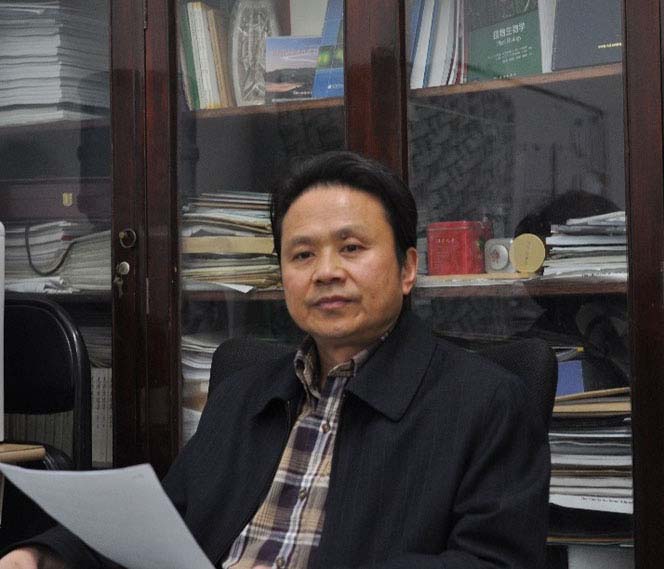

一氧化氮介导蛋白质亚硝基化与甲基化协调植物非生物胁迫的分子机制
The Molecular Mechanism of Nitric Oxide-mediated S-nitrosylation Coordinating with Protein Methylation During Abiotic Stress Responses
Received date: 2017-09-20
Accepted date: 2017-11-02
Online published: 2017-11-02
一氧化氮(NO)作为一种具有活性的小分子物质参与众多动植物生理活动。在蛋白转录后修饰方面, NO主要以S-亚硝基化(S-nitrosylation)的形式参与。而甲基化作为另一种蛋白翻译后修饰, 在DNA损伤及mRNA翻译方面具有重要作用。虽然近年来有关这2种蛋白翻译后修饰方面的研究成果较多, 但是2种途径之间是否存在相互作用却报道较少。近期, 我国科学家发现NO可以通过S-亚硝基化修饰PRMT5的第125位半胱氨酸, 正向调节该精氨酸甲基转移酶活性。prmt5-1突变体表现出严重的发育障碍且对非生物胁迫敏感。通过互补第125位半胱氨酸点突变PRMT5基因, 使之转化为不可被S-亚硝基化修饰的氨基酸后, 拟南芥(Arabidopsis thaliana)植株可恢复突变体的发育障碍, 但无法恢复其非生物胁迫敏感表型。实验同时证明, PRMT5蛋白第125位半胱氨酸的S-亚硝基化修饰参与调节NaCl诱导的精氨酸对二甲基化。该研究引领了蛋白S-亚硝基化和蛋白甲基化修饰新方向, 开辟了新的研究领域, 同时为相关研究树立了新的榜样。

王宇 , 何奕騉 . 一氧化氮介导蛋白质亚硝基化与甲基化协调植物非生物胁迫的分子机制[J]. 植物学报, 2017 , 52(6) : 681 -684 . DOI: 10.11983/CBB17177
Nitric oxide, as a small active particle, is involved in many physiological activities of animals and plants. In protein posttranslational modifications, NO is mainly in the form of (NO)-based S-nitrosylation. Methylation, as another protein transcription modification, also has an important role in DNA damage and mRNA translation. Although these two areas have many published articles in recent years, there are few reports of the interaction between the two approaches. Recently, Chinese scientists have found that NO can positively regulate the activity of PRMT5, an enzyme that catalyzes Arg symmetric demethylation, through S-nitrosylation at Cys-125. The Arabidopsis prmt5-1 mutant shows severe deve- lopmental defects and hypersensitivity in stress responses. A PRMT5C125S transgene with non-nitrosylatable mutation at Cys-125 in a prmt5-1 background shows recovered developmental defects but not the stress responses. Furthermore, S-nitrosylation at Cys-125 of PRMT5 was found involved in regulating Arg symmetric demethylation induced by NaCl. The study led to a new direction of protein S-nitrosylation and protein methylation modification, which opened up new research fields and set a new example for research in this field.

| [1] | Astier J, Rasul S, Koen E, Manzoor H, Besson-Bard A, Lamotte O, Jeandroz S, Durner J, Lindermayr C, Wendehenne D (2011). S-nitrosylation: an emerging post- translational protein modification in plants.Plant Sci 181, 527-533. |
| [2] | Bedford MT, Clarke SG (2009). Protein arginine methylation in mammals: who, what, and why.Mol Cell 33, 1-13. |
| [3] | Chen RQ, Sun SL, Wang C, Li YS, Liang Y, An FY, Li C, Dong HL, Yang XH, Zhang J, Zuo JR (2009). The Arabidopsis PARAQUAT RESISTANT2 gene encodes an S-nitrosoglutathione reductase that is a key regulator of cell death. Cell Res 19, 1377-1387. |
| [4] | Feechan A, Kwon E, Yun BW, Wang YQ, Pallas JA, Loake GJ (2005). A central role for S-nitrosothiols in plant disease resistance. Proc Natl Acad Sci USA 102, 8054-8059. |
| [5] | Frungillo L, Spoel SH (2017). Modulating the modulator: regulation of protein methylation by nitric oxide.Mol Cell 67, 535-537. |
| [6] | Hess DT, Matsumoto A, Kim SO, Marshall HE, Stamler JS (2005). Protein S-nitrosylation: purview and parameters. Nat Rev Mol Cell Biol 6, 150-166. |
| [7] | Hu JL, Yang HJ, Mu JY, Lu TC, Peng JL, Deng X, Kong ZS, Bao SL, Cao XF, Zuo JR (2017). Nitric oxide regulates protein methylation during stress responses in plants.Mol Cell 67, 702-710. |
| [8] | Tada Y, Spoel SH, Pajerowska-Mukhtar K, Mou ZL, Song JQ, Wang C, Zuo JR, Dong XN (2008). Plant immunity requires conformational charges of NPR1 via S-nitrosy- lation and thioredoxins. Science 321, 952-956. |
| [9] | Tavares CP, Vernal J, Delena RA, Lamattina L, Cassia R, Terenzi H (2014). S-nitrosylation influences the structure and DNA binding activity of AtMYB30 transcription factor from Arabidopsis thaliana. Biochim Biophys Acta 1844, 810-817. |
| [10] | Wang PC, Du YY, Hou YJ, Zhao Y, Hsu CC, Yuan FJ, Zhu XH, Tao WA, Song CP, Zhu JK (2015). Nitric oxide negatively regulates abscisic acid signaling in guard cells by S-nitrosylation of OST1. Proc Natl Acad Sci USA 112, 613-618. |
| [11] | Yang HJ, Mu JY, Chen LC, Feng J, Hu JL, Li L, Zhou JM, Zuo JR (2015). S-nitrosylation positively regulates ascor- bate peroxidase activity during plant stress responses. Plant Physiol 167, 1604-1615. |
/
| 〈 |
|
〉 |